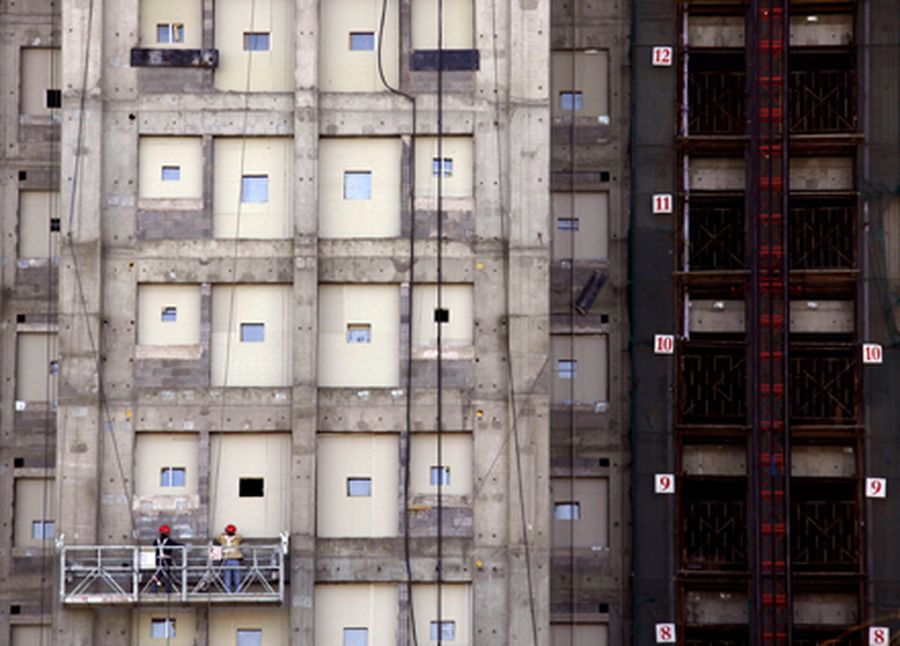Singapore’s biggest IPO of the year came to market at a time when listings in North Asia were struggling, highlighting the SGX’s ability to mobilise big capital commitments even in difficult markets.

Source: Reuters/David Gray
Construction workers stand on a platform as it hangs on the front of a new apartment block in Beijing
Singapore’s primary equity market, in common with most of Asia, has been very fragile this year, with few large IPOs and several deals withdrawn. Even real-estate investment trusts, viewed as more stable forms of equity investments, due to their predictable dividend streams, have been casualties. M&L REIT pulled its S$509m (US$417m) hospitality IPO in April after a week of bookbuilding, and Ascendas Hospitality Trust pushed its float to July from May.
Against such a backdrop, it seemed hard to believe that Singapore’s largest IPO of the year to date would be a hospitality REIT.
Far East Organization, Singapore’s largest property developer, had started a process to streamline its hospitality holdings at the beginning of last year to put them into a tax-efficient structure.
Listed developer Orchard Parade Holdings, now renamed Far East Orchard, had two hotels and one serviced apartment, which it decided to put into a new REIT, along with eight other properties from privately held FEO, to be listed under the name Far East Hospitality Trust.
Although FEO holds large stakes in SGX-listed Far East Orchard and Yeo Hiap Seng, this was the first IPO from the group.
“We thought, if the market was fairly stable, we should just go ahead, because we’re in it for the long-haul, not just trying to catch the market at the top of the cycle,” said Gerald Lee, CEO of Far East Hospitality Asset Management, the manager of Far East H-Trust.
The decision to push ahead with its offering in August, typically a barren month for IPOs, paid off. The deal, priced at the top of its S$0.86–$0.93 per share guidance, was more than 30x covered on the institutional tranche.
Since listing, the stock has traded up around 10% and its greenshoe of 65.9m shares was exercised in full, lifting the deal size to S$717.6m.
“At least one of the banks advised us to delay because of the summer season,” said Lee. “People were concerned we would not be able to contact investors.”
DBS, Goldman Sachs and HSBC were joint global co-ordinators of the Reg S offering and bookrunners with OCBC.
The deal had huge interest from cornerstones, but, on the advice of bookrunners, was launched with cornerstone commitments for around 50% of the institutional tranche.
Lee said the main concern was to balance the liquidity of the stock with the desire to give confidence to investors with top-tier cornerstones. In the end, high-quality names, including AIA, Aberdeen and Jardine Fleming, participated as cornerstones. The institutional tranche was more than 30x covered, with strong interest from European accounts, as well as the usual Asian investor base.
Strong support enabled the offering to price at a tight forecast dividend yield of just 6.3% for 2013. “There is yield compression, but it’s at a level that’s sustainable,” said Lee.
FEO marketed the hospitality trust on its belief that Singapore would continue to grow as a regional business hub, and tourist traffic would also grow as the result of government investments in new attractions and infrastructure.
Solid cornerstones
However, to provide some extra support, FEO decided to structure the IPO as stapled securities of the REIT and a business trust – the same structure that listed peer CDL Hospitality Trust used.
This enabled the issuer to put in place a “master lessee” structure with fixed and variable components. Master lessees are original property owners who sold the assets to the REIT.
“Given a choice, we would rather go for a REIT, but this is an asset class with a shorter tenancy period than shopping malls and industrial properties,” said Lee. “If there is a major crisis and occupancy plunges, the master lessees will have to cough up the fixed amount that is their commitment.”
It also means that, if the REIT were to acquire a property from a third-party vendor that did not want to be a master lessee, the business trust, which is currently dormant, would be able to take over the responsibility as a master lessee of last resort.
This was a key difference from some other trusts, and Lee acknowledged that the structure might have confused some retail investors.
Some other REITs to come to market in Singapore recently have had a pan-Asian mandate, whereas Far East H-Trust benefited from the simpler proposition of being a pure Singapore play. It is committed to keeping its portfolio focused on Singapore assets for the first three years, after which it will consider whether or not it makes sense to diversify.
“We will see if other markets are similar to Singapore in terms of their risk profiles,” said Lee. “Our pipeline assets should keep us busy for the next five years in Singapore.” Seven properties have been identified as assets to be injected in the next few years.
The trust currently has a gearing of around 30%, although Lee says it is comfortable to increase this level to up to 40%. It plans to obtain a credit rating in the next few months, which is necessary for it to raise its gearing beyond 35%.
To see the digital version of this report, please click here.
